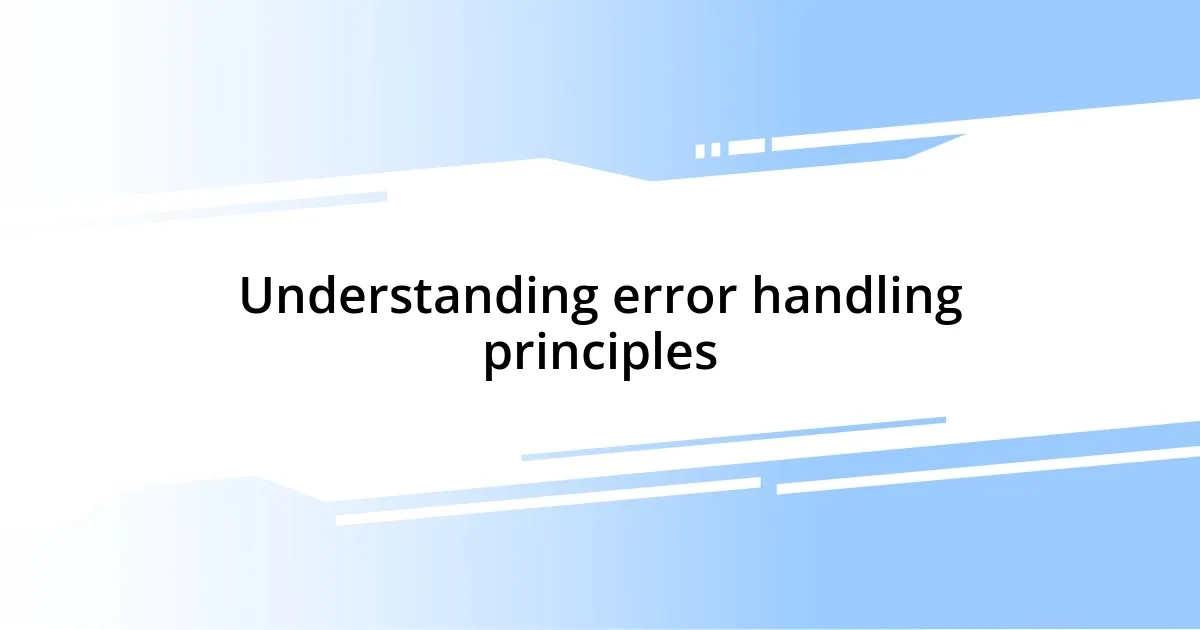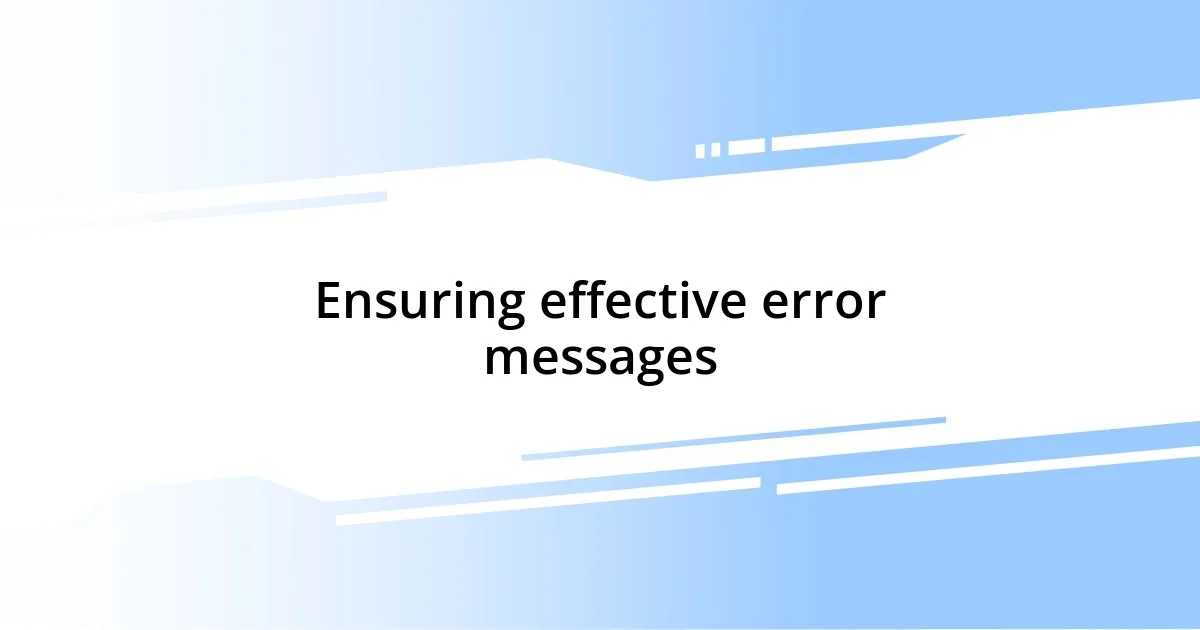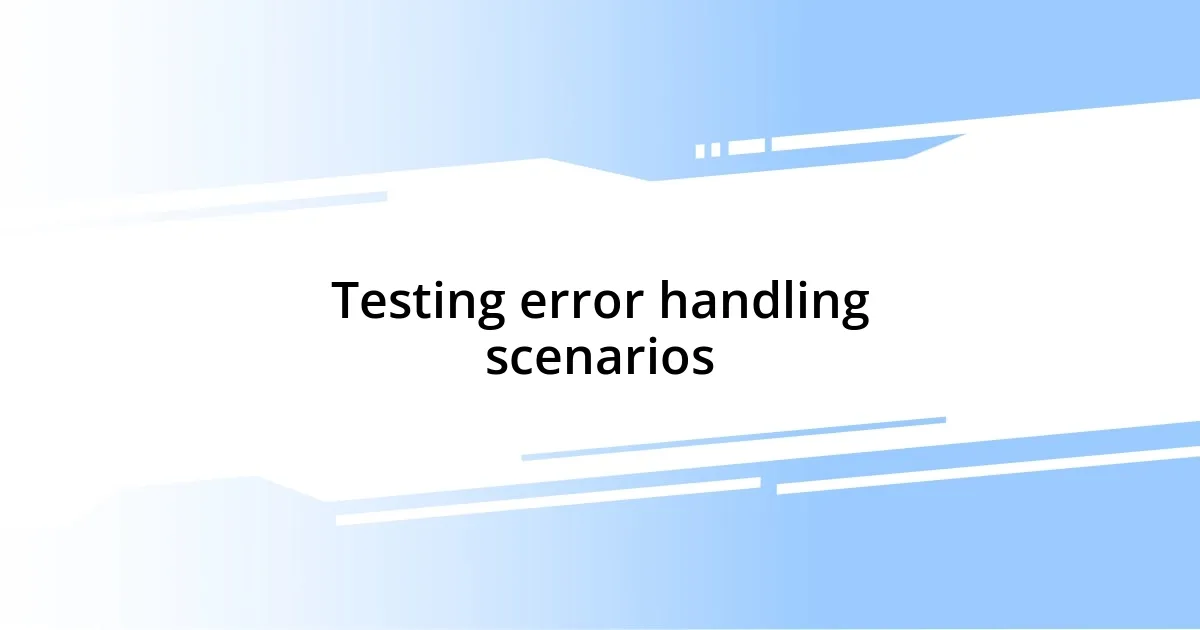Key takeaways:
- Understanding Ruby’s error handling involves using the
begin...rescueblock to capture and manage errors gracefully, preventing application crashes. - Common Ruby errors like
NoMethodErrorandArgumentErrorhighlight the importance of validating objects and arguments to avoid unexpected failures. - Creating custom exception classes allows for better error categorization and informative messages, enhancing clarity and debugging efficiency.
- Testing error handling scenarios helps developers anticipate and address edge cases, transforming error management from a reactive to a proactive practice.

Understanding error handling principles
Error handling in Ruby is fundamentally about anticipating issues that may arise while a program is running. I remember the first time I encountered a runtime error; it felt like a punch to the gut! It made me realize how crucial it is to understand the principles behind error management instead of merely trying to fix the immediate problem.
At its core, error handling revolves around the concept of rescuing from failure and ensuring that your program can respond gracefully. Have you ever wondered what happens when an unexpected situation surfaces? In Ruby, using the begin...rescue block can help you capture errors without crashing the entire application. It made a world of difference for me when I learned to embrace this pattern—I started seeing errors as opportunities to improve rather than as roadblocks.
Moreover, error handling is not just about catching exceptions, but also about logging and informing. I often reflect on how vital it is to provide meaningful feedback for debugging. Wouldn’t you agree that a well-documented error message can save hours of head-scratching later on? By taking the time to craft informative outputs, I’ve found it empowers both developers and users to understand and rectify issues more efficiently.

Common error types in Ruby
Common error types in Ruby can often leave developers scratching their heads, especially when they first encounter them. One type of error that’s particularly notorious is the NoMethodError. I remember when I mistakenly called a method on a nil object—talk about an embarrassing moment! It was a stark reminder for me to double-check my objects before calling methods. Another common culprit is the ArgumentError, which usually crops up when the wrong number of arguments is passed to a method. This has happened to me when I was certain I’d included everything; learning to use keyword arguments helped clarify my intentions.
Here are some common error types you’ll encounter in Ruby:
- NoMethodError: Raised when you call a method that doesn’t exist for the object.
- ArgumentError: Occurs when the wrong number of arguments are given to a method.
- TypeError: Happens when an operation is attempted on an object of an inappropriate type.
- NameError: Triggered when trying to reference a variable or method that isn’t defined.
- RuntimeError: A general error that can be raised by custom code or libraries when a condition is not met.
It’s fascinating how these errors can teach us a lot about coding practices and the importance of writing robust code.

Using begin and rescue blocks
Using begin and rescue blocks is a cornerstone of error handling in Ruby. This approach allows developers to wrap potentially risky code with a safety net. When I first began incorporating these blocks into my projects, I felt a shift in how I approached coding. Handling potential errors became less about fear and more about preparation—like bringing an umbrella when the forecast looks cloudy.
Imagine you’re reading a novel, and suddenly, the plot takes an unexpected turn—a cliffhanger that leaves you on edge. That’s how exceptions can feel if you don’t use begin...rescue. When an error occurs within the begin block, the code in the rescue segment kicks in, and you can handle the error gracefully. The first time I saw this in action, it was like watching a well-executed strategy unfold. Instead of the program failing entirely, I could log the error and continue running other operations. It’s truly empowering!
This pattern can also be extended using ensure, which runs code regardless of whether an error occurred. I once had a situation where cleanup tasks—like closing a file—were essential, even if an error happened. Using begin...rescue...ensure helped me ensure that everything functions smoothly, no matter the circumstances. Applying these practices not only improved my coding confidence but also made my applications significantly more robust.
| Block | Description |
|---|---|
| Begin | This block contains the risky code that might raise an error. |
| Rescue | Handles the error, allowing us to define how the program should respond to specific exceptions. |
| Ensure | Code that runs no matter what—whether an error was raised or not, useful for cleanup operations. |

Ensuring effective error messages
When it comes to error messages in Ruby, clarity is paramount. I recall a time when I encountered a vague error message that left me more confused than informed. It was a frustrating experience that taught me the importance of crafting error messages that are not only descriptive but also actionable. When I write error messages, I ensure they not only indicate what went wrong but also provide possible solutions or next steps for resolution. Have you ever found yourself staring at an error, wondering what to do next? Effective messages can prevent that moment of dread.
I’ve learned that adding context to error messages can make all the difference. For example, if I’m validating user input, I try to include what was expected versus what was received. This practice not only aids in debugging but also serves as a guide for others reading the code later. When I implemented clearer messages in my projects, I noticed a tangible reduction in confusion during team collaborations. This makes sense, right? A simple message can turn a frustrating situation into an opportunity for growth and learning.
Moreover, standardizing error messages across your application helps in maintaining consistency. I remember distinctly when I joined a project with an inconsistent approach to error handling—it created chaos. Some messages were terse, while others were overly technical. By implementing a uniform style, it not only streamlined debugging but also enhanced the overall readability of our code. Isn’t it comforting to know that a little attention to detail can save hours in troubleshooting down the line?

Best practices for logging errors
Logging errors effectively is crucial for any Ruby application. I’ve often found myself sifting through piles of logs to understand an issue, so I’ve learned the importance of structured logging. When I first experimented with different logging formats, switching to a structured approach like JSON made it so much easier to parse and analyze errors later. Have you ever felt overwhelmed by unorganized logs? With structured logging, it’s like having a well-organized library—it saves so much time!
Using log levels is another best practice that I can’t stress enough. I remember the time I neglected to categorize my logs properly, leading to a flood of irrelevant information during a critical system failure. By implementing different log levels—like DEBUG, INFO, WARN, and ERROR—I could quickly filter and focus on what really mattered. This not only expedited the debugging process but also helped me maintain a clear overview of the application’s health. Do you think that a few categories might simplify your work, too?
Finally, I recommend including contextual information in your logs. For instance, I used to log exceptions without providing any details about the request or the user involved, which made debugging a nightmare. Now, I always ensure that logs include vital information, such as timestamps, user IDs, and specific actions leading to errors. This practice has made it so much easier to trace back issues and rectify them swiftly. Think about how much simpler it would be to solve problems with this additional context!

Creating custom exception classes
Creating custom exception classes in Ruby is an excellent way to handle errors more effectively. I distinctly remember the time I grappled with a library that threw generic errors, leaving me perplexed. By crafting my own exception classes, such as InvalidUserInputError, I could provide my team with precise context about what went wrong. Doesn’t it feel empowering to pinpoint issues with more than just a generic message?
When I implemented custom exception classes, I also found that I could group related errors together. For instance, by having specific classes for different validation errors, I could streamline my error handling and improve the readability of my code. This not only made my work more efficient but also allowed other developers to understand the error landscape at a glance. Have you ever faced a situation where categorization helped you avoid a rabbit hole of confusion?
Moreover, it’s essential to leverage your custom exceptions to provide meaningful error messages. I take pride in integrating error messages within these classes that guide users on how to correct their mistakes. For instance, if a UserNotFoundError occurs, I might include suggestions to check the username format or try a different search term. This approach transforms an error from a mere obstacle into a potential learning moment. Wouldn’t you agree that turning errors into opportunities enriches not only your code but also your understanding as a developer?

Testing error handling scenarios
Testing error handling scenarios is an integral part of ensuring robust Ruby applications. I often create test cases that deliberately trigger errors to observe how my application reacts. Once, while testing a file upload feature, I simulated an unexpected file type, and to my surprise, the app didn’t handle it gracefully. The realization that my code could fail so dramatically pushed me to refine my error handling further, and now I ensure that every edge case is addressed.
When I first started writing tests, I didn’t fully appreciate the value of simulating different error scenarios. I remember a particularly stressful situation where my application crashed because I had overlooked a possible network timeout. Since then, I’ve embraced the practice of running tests that mimic real-world failures, like database connection losses. It’s almost like putting my code through a rigorous training camp to prepare for the unpredictable nature of the world outside. Does it ever feel daunting to anticipate every possible failure?
I’m now a firm believer in the mantra that “failing fast” leads to learning faster. In my experience, when I intentionally simulate errors—like invalid user input or authentication failures—I’ve uncovered critical gaps in my error handling strategy. For example, testing how my application responds when it encounters a UserNotFoundError showed me that I had missed an opportunity to provide users with better guidance in the error message. This approach hasn’t just improved my coding practices; it has transformed my mental model about error handling, making it a proactive rather than reactive part of my development process. How do you feel about putting your code through such trials?














